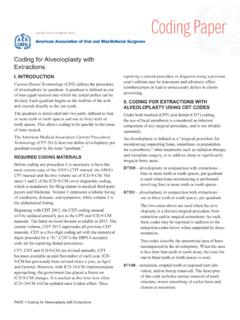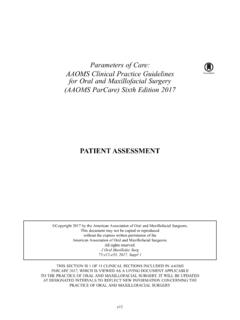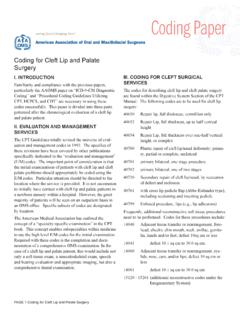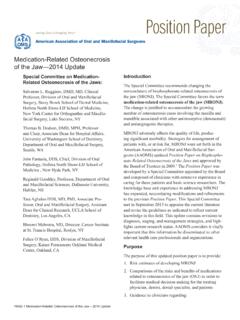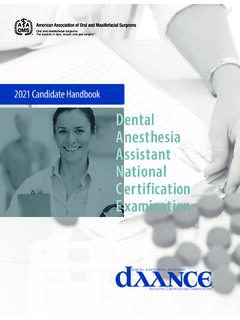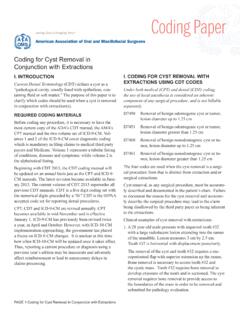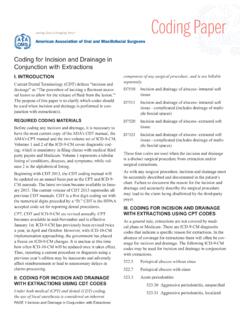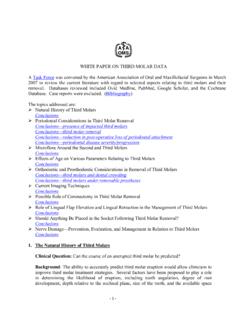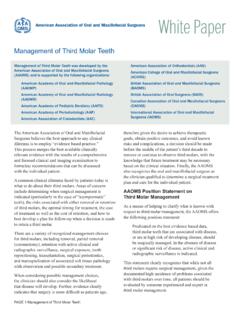Transcription of Supporting Information to the Management of Patients with ...
1 Supporting Information to the Management of Patients with Third Molar TeethThe following Information is intended as resource material regarding the Management of third molar teeth. As in all matters of decision-making, the AAOMS believes that relevant evidence should be fairly interpreted by those who are expert, experienced and active in the Management of Patients with third molars, using an organized approach to evaluate the validity and clinical relevance of the evidence. Where there is an absence of conclusive evidence, the available evidence should be interpreted and used in a manner that is most likely to benefit the patient, consider-ing both short and long-term consequences of removal and retention Molars Are DifferentThird molars are different from other teeth in important ways, highlighted by their greater frequency and severity of disease and the fact they are typically non-functional.
2 The differences are, to a large degree, secondary to their location, as they are the most distal teeth in the dental arch and the last to erupt into the oral cavity, leaving less physiologic space for eruption and maintenance. The result is poor quality soft tissue support that often leads to percolation of bacteria beneath the gingival tissues surrounding the third molar. This contributes to subclinical inflammation that often progresses to pericoronitis and infection. Periodontal pocketing is frequently found around third molars as well as dental caries, which are difficult to restore. In addition, the roots of these teeth, particularly with increasing age, are more likely to approximate important anatomic structures such as the maxillary sinus, adjacent teeth and the neurovascular canal.
3 Additionally, they are often positioned in places where associated infec-tions may become more of an issue due to the position of the myohyloid muscle and thin area of the lingual cortical plate, which can be predisposed to bacterial migration to adjacent fascial spaces. PAGE 1 Supporting Information to the Management of Patients with Third Molar TeethPathologies Known to be Associated with Third Molar TeethThere are well-documented pathologies associated with retained third molars. These include but are not limited to:1) Dental caries 2) Pericoronitis 3) Root resorption 4) Periodontitis 5) Infections (local and fascial space) 6) Cysts 7) Tumors 8) Mandible fractures. Potential Adverse Outcomes Associated with Surgical Management of Third MolarsAs with any form of treatment, complications may occur secondary to any Management approach, including reten-tion.
4 Complications from third molar removal are gener-ally minor and resolve within a few days. Problems that may be associated with the removal of third molars include inflammatory complications such as infection or osteitis, hemorrhage, injury to adjacent anatomic structures, teeth or nerves, periodontal defects, fractures of maxillary tuberosity or mandible, persistent oral-antral communica-tion, retained roots and the need for additional treatment to manage complications. Consequences of Third Molar RetentionThe risks and implications of third molar retention include all the known associated third molar pathologies noted previously. While the incidence of problems associated with retained third molars is not completely understood, recent papers help clarify what happens to retained third molars over time.
5 Two papers in particular are noteworthy. American Association of Oral and Maxillofacial SurgeonsThe first article reflects the work of McArdle and Renton(1), who reviewed the effects of the United Kingdom s Guidelines over a decade and concluded that, while initially the incidence of third molar removal was decreased as a result of these guidelines, it is now as common as it was before their institution. They also found that the dynamics of removal were altered. They reported that the mean age of Patients undergoing removal increased and the reason for extraction changed to predom-inately include caries, periodontal disease and pericoronitis rather than impaction. The second article documents the findings of a group of experienced clinicians who asked the question; Among adults who elect to retain their asymptomatic third molars, what is the risk that one or more third molars will be extracted in the future?
6 (2) They conducted a systematic review of the literature. Studies included were prospective, had sample sizes 50 subjects with at least one asymp-tomatic third molar and at least 12 months of follow-up. They found that the mean incidence rate for the extraction of previously asymptomatic retained third molars ranged from 5% at one year to 64% at 18 years, with the predom-inant reasons for extraction caries, periodontal disease and other inflammatory conditions. They concluded that the cumulative risk of third molar extraction for young adults with asymptomatic third molars is sufficiently high to warrant discussion when reviewing the risks and benefits of third molar retention as a Management strategy.
7 In light of the above and given that the absence of symptoms does not equal the absence of disease, it is clear Patients who elect to retain their third molars should be followed with active surveillance including recommenda-tions regarding the frequency of regular follow-up visits. Despite the fact that most Patients will eventually require removal of their third molars, some will be able to main-tain these teeth for a lifetime. At this time, we cannot say with confidence what the future will be for all Patients with asymptomatic disease-free teeth. However, there are some things that we do know about their behavior and Management . Evidence-Based Facts about Third Molar Behavior and Management1) Third molars are different from other teeth in signifi-cant ways.
8 2) An absence of symptoms associated with third molars does not equate to the absence of ) Retained third molars frequently and unpredictably change position, eruption and periodontal status. 4) The microbial biofilm associated with partially erupted third molars and pericoronitis is conducive to the development of periodontal disease. 5) Periodontal disease in the third molar area begins with their eruption. 6) Pocketing around third molars is an important indica-tor of periodontal disease, especially when bleeding occurs on probing. 7) Third molars with probing depths greater than 4mm increase the risk for developing anterior pocketing. 8) Extraction of a third molar reduces the risk for periodontal disease in young adults.
9 9) There are identifiable risk factors for delayed healing and surgical complications associated with third molar ) There are identifiable ways to improve post-operative healing and ) The majority of Patients with retained, asymptomatic disease-free third molars eventually require surgical Management . 12) When Patients elect to retain their third molars, the frequency of future disease is sufficiently high that active surveillance is a superior Management strategy when compared with symptomatic as needed follow-up. Evidence-Based Statements Likely Valid but Requiring Further Study:1) While it is likely that most third molars will develop pathology over time, there is uncertainty in identify-ing those that can be ) There are costs associated with the active surveillance of retained third molars, which may be more expen-sive than extraction in the long term.
10 PAGE 2 Supporting Information to the Management of Patients with Third Molar Teeth3) While it makes biologic sense that systemic diseases may be linked to the oral inflammation associated with third molars, current evidence for a cause and effect link is suggestive rather than definitive. Recommendations Supported by Clinically Relevant Evidence:1) Surgical Management of third molars is appropriate when there is evidence of pathology. 2) Surgical intervention or removal of third molars prior to the development of pathology should be consid-ered in Patients who have insufficient physiologic space for eruption and maintenance at a time when the post-surgical healing is optimal and the risk of complications low.
